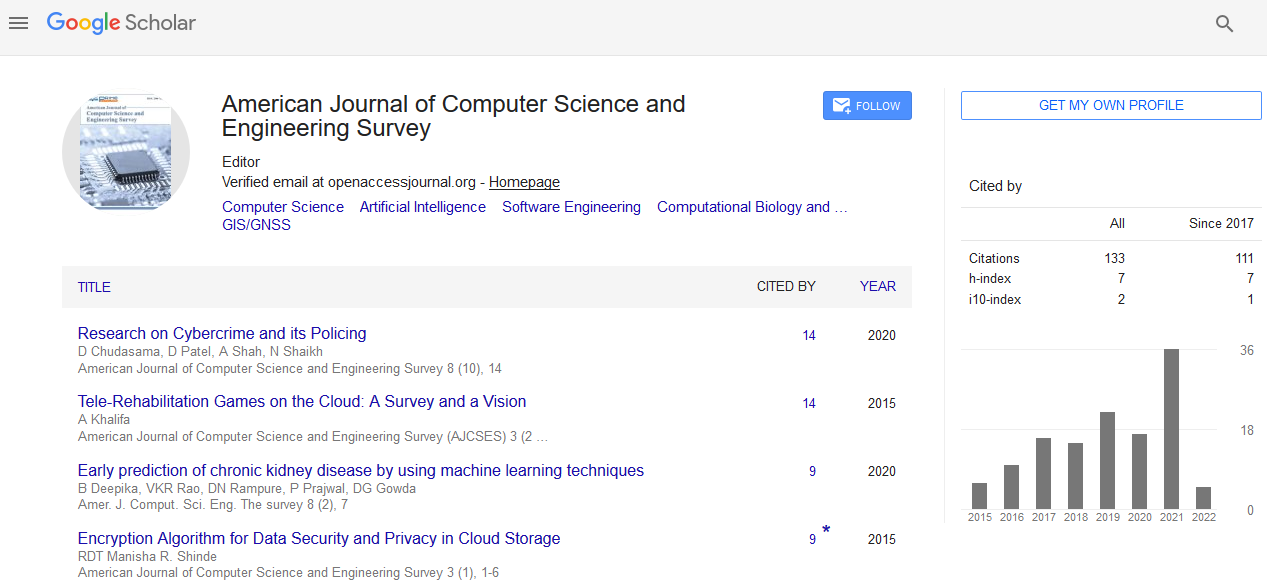Commentary Article - (2022) Volume 10, Issue 2
Deep Learning Enabled Signal Modulation
Vijay M*
Department of Electronics and Communication, Velammal Institute of Technology, India
*Correspondence:
Vijay M, Department of Electronics and Communication, Velammal Institute of Technology,
India,
Email:
Received: 02-Mar-2022, Manuscript No. IPACSES-22- 13016;
Editor assigned: 04-Mar-2022, Pre QC No. IPACSES-22- 13016(PQ);
Reviewed: 18-Mar-2022, QC No. IPACSES-22- 13016;
Revised: 23-Mar-2022, Manuscript No. IPACSES-22- 13016(R);
Published:
30-Mar-2022, DOI: 10.36846/2349-7238-10.2.8
Description
Submerged Acoustics (UWA) is viewed as one of the further
developed remote transmission advances. UWA channels entangle
transmission because of their own attributes: expanded
term, extreme intersymbol obstruction (ISI), and thin transfer
speed. These elements truly influence the soundness of the
transmission strategy and forestall quicker UWAs. UWA’s Auto
Modulation Classification (AMC) has gotten incredible interest
with different applications in regular citizen and acoustic submerged
a conflict situations. Notwithstanding, conventional
tweak arrangement approaches are not productive enough in
shallow conditions because of the challenges of marine conditions,
for example, resonation, drive commotion, various
multipass ways, limited data transfer capacity, and complex
submerged acoustic channels with long postponements. Along
these lines, it is vital to concentrate on the adjustment identification
strategy that is more appropriate for the UWA channel.
AMC is a significant piece of data recuperation and quality ID
of gotten signals. As of late, AMC for UWA transmission signals
has turned into a hot examination point with the rising interest
for sea data assortment and developing sea related advances.
Be that as it may, because of the brutal marine climate, progress
in the area has been exceptionally sluggish. Particularly in
military applications, sent signals are frequently multiplexed
and short circuits increment the intricacy of AMC. Customary
AMC-to-UWA transmission signals were fundamentally founded
on an example acknowledgment approach. This should be
possible in two stages: order and element extraction. In the
first place, various elements are based on the area information
and later went into various classifiers for grouping. As a
general rule, AMC strategies fall into two classes: highlight
based design acknowledgment and likelihood based choice
hypothetical techniques. Work based techniques are broadly
utilized due to their low intricacy and great execution. Conventional
component based AMC procedures incorporate two
principle stages: arrangement and element extraction. In the
component extraction stage, different highlights, for example,
Stockwell change, wavelet change, higher request cumulants and minutes were adjusted. For classifiers, support vector machines
(SVMs), choice tree classifiers, bunching calculations,
and brain network classifiers are normally utilized in the characterization
stage. Be that as it may, this technique requires an
immense measure of ability and earlier information to foster
a component extraction model. In circumstances of absence
of earlier information, speculation and exactness are many
times deficient, particularly in complex UWA channels. As of
late, profound learning (DL) techniques have accomplished
brilliant execution in a few regions, particularly arrangement
assignments, since they can learn undeniable level elements
concealed in the information. Adjustment order utilizing the DL
approach is turning into an undeniably significant field of study.
It has likewise been shown that straightforward convolutional
brain organizations (CNNs) are better than radio adjustment
calculations in many years of master work recovery. This examination
has fostered another EDLMSC procedure for ordering
tweaked signals present in submerged acoustic interchanges.
The EDLMSC strategy comprises of a few subprocesses: a drive
commotion based pre-processor, an outfit of DL-based characterizations
(GRU, BiLSTM, and SSAE), and BWO-based hyper
parameter tuning. Applying the BWO calculation assists with
choosing the right hyper parameter values for the DL model,
accordingly further developing order execution. Complete relative
examinations have been directed to explore the superior
proficiency of the EDLMSC strategy, and the outcomes show
upgrades to the EDLMSC approach over ongoing methodologies
concerning different means. Accordingly, EDLMSC innovation
can be utilized as a compelling apparatus for ordering
regulated signals in submerged acoustic interchanges.
Acknowledgement
None.
Conflict of Interest
The author declares there is no conflict of interest in publishing
this article.
Citation: Vijay M. (2022) Deep Learning Enabled Signal Modulation. Am J Comp Science Eng Surv. 10:8.
Copyright: ©Vijay M. This is an open-access article distributed under the terms of the Creative Commons Attribution License, which permits unrestricted use, distribution, and reproduction in any medium, provided the original author and source are credited.

